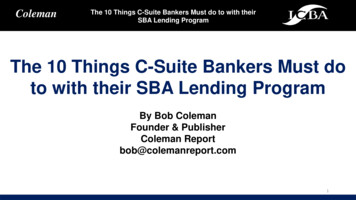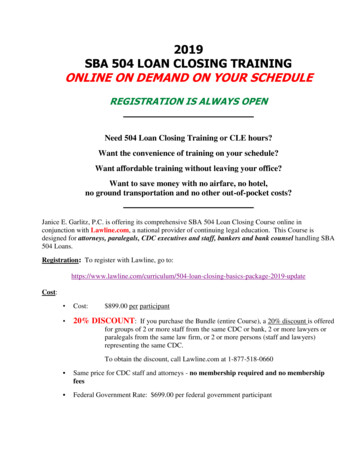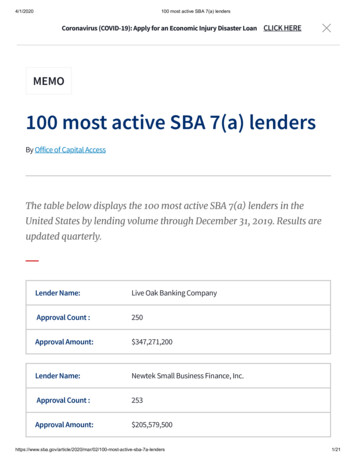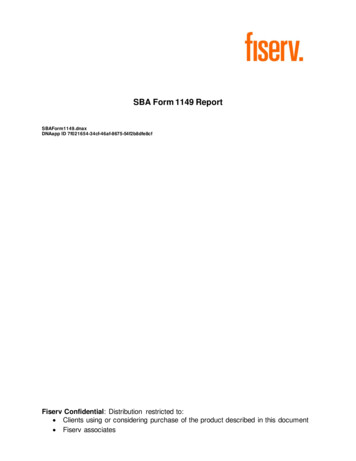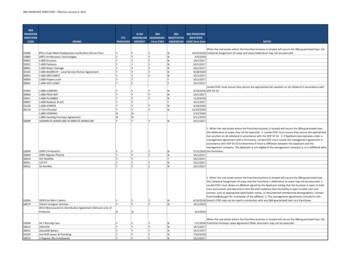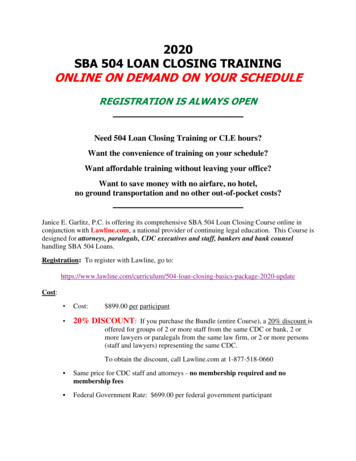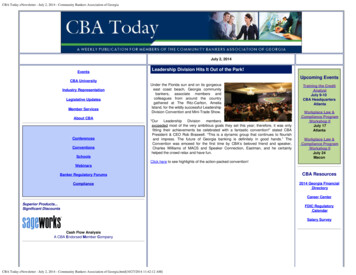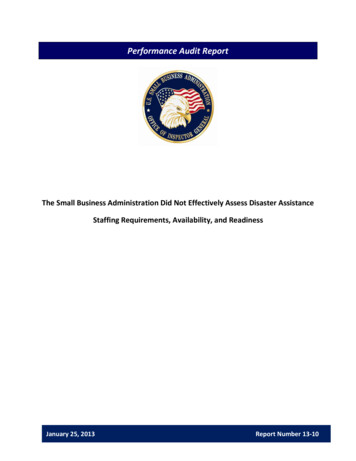
Transcription
Performance Audit ReportThe Small Business Administration Did Not Effectively Assess Disaster AssistanceStaffing Requirements, Availability, and ReadinessJanuary 25, 2013Report Number 13-10
U.S. Small Business AdministrationOffice of Inspector GeneralWashington, D.C. 20416REPORT TRANSMITTALREPORT NO. 13-10DATE:January 25, 2013T O:James E. Rivera, Associate Administrator, Office of Disaster AssistanceSteven G. Smith, Director, Office of Disaster PlanningSUBJECT:The Small Business Administration Did Not Effectively Assess Disaster AssistanceStaffing Requirements, Availability, and ReadinessThis report presents the results of our audit on the Small Business Administration’s staffing andmobilization activities. Specifically, this report addresses the SBA’s: (1) assessment of human capitalneeds during the biennial simulation exercise, and (2) ability to accurately identify the total number ofreserve staff available to respond to disasters. We have incorporated the formal comments from theOffice of Disaster Assistance (ODA) and the Office of Disaster Planning (ODP) into this report.Please provide your response to this report for each recommendation on the attached SBA Forms 1824,Recommendation Action Sheet, by February 24, 2013.Consistent with OMB Circular A-50, your response should include the corrective action(s) taken orplanned for each recommendation and the target date(s) for completion. If you disagree with therecommendations, please fully explain the reasons for disagreement. Please include the legal basis fordisagreement based on interpretation of law, regulations, or the authority of officials to take or not totake action. You may also propose alternative actions to those recommended that you believe wouldbetter address the issues presented in this report.In order to fulfill our responsibility under the Inspector General Act, we are providing copies of ourreport to the appropriate congressional committees responsible for oversight of the Small BusinessAdministration. We will also post this report on the Office of Inspector General website for publicdissemination.We appreciate the courtesies and cooperation of the ODA and the ODP during this this audit. If youhave any questions concerning this report, please call me at (202) 205-7390, or Craig Hickok, Director,Disaster Assistance Audit Group at (817) 684-5341.***/s/John K. NeedhamAssistant Inspector General for Auditing
The Small Business Administration Did NotEffectively Assess Disaster Assistance Staffing Requirements,Availability, and ReadinessWhat OIG AuditedWe audited the SBA disaster assistance program’sstaffing and mobilization activities to determine itsreadiness to respond to a large scale event.Specifically, we examined whether the SBAmaintained a sufficient workforce to respond to acatastrophic event equivalent to the 2005 GulfCoast Hurricanes. We reviewed the Agency’splanning and execution of its staffing strategies,evaluated the 2008 and 2010 Senior LeadershipSeminar After Action Reports, interviewed officialsfrom the Office of Disaster Assistance (ODA) andOffice of Disaster Planning (ODP), and analyzedpersonnel rosters.1. Develop a plan that ensures the biennialsimulation exercise includes an assessment ofhuman capital necessary to respond to the levelof disaster selected for the simulation exercisescenario.2. Implement a corrective action plan to addressdeficiencies identified during the biennialsimulations.Corrective actions should beassigned to responsible parties and have duedates. They should also be tracked duringimplementation and then validated duringsubsequent exercises.The remaining two actions were addressed to theAssociate Administrator for Disaster Assistance:What OIG FoundThe Agency’s biennial simulation exercise did notsufficiently assess whether the SBA could activatethe human capital necessary to respond to adisaster larger than the 2005 Gulf Hurricanes.Additionally, the Agency lacked a formal process tomonitor or verify implementation of simulationexercise recommendations. Further, the Agency didnot have a formalized process to maintain anaccurate accounting of the reserve workforce andtheir availability.If another disaster of a magnitude similar to the2005 Gulf Hurricanes occurs, the Agency couldencounter challenges in meeting staffing needs toachieve their mission. Specifically, the Agencywould need to hire and train approximately 2,400new employees to respond adequately to a majorcatastrophic event. During the Gulf Hurricanes,training and supervising a large influx of temporarystaff proved very difficult for the SBA.OIG Recommendations and Agency CommentsThe OIG recommended a total of four actions. Weaddressed two actions to the Director of ODP:3. Develop a process that accurately identifies thetotal number of reserve staff available formobilization and specifies the frequency of suchan analysis.4.Develop written procedures that define ODA’sprocess for determining the number of reservestaff available to respond to disasters.On January 4, 2013, management submitted formalcomments.Management concurred with ourfindings and all four recommendations.Actions TakenAs of report issuance, the ODA has implemented aprocess that identifies the staff available formobilization and has developed written proceduresfor determining the number of reserve staffavailable for disaster response. In addition, theODP and other offices are presently executing aplan that incorporates a detailed improvement planwith responsibilities and due dates.
Table of ContentsIntroduction . 1Background . 1The Small Business Disaster Response and Loan Improvements Act of 2008 . 2Biennial Simulation Exercises and SBA’s Disaster Recovery Plans. 2Results . 3Finding: The SBA’s Biennial Simulation Exercise Did Not Assess Human Capital Needs . 3Post-Exercise Evaluation . 4Corrective Action Plans . 4Office of Disaster Assistance Lacked a Process for Identifying Available Workforce . 5Availability Testing . 5Conclusion . 6Recommendations . 7Agency Comments and Office of Inspector General Response . 8Appendix I: Scope and Methodology . 10Prior Coverage. 11Appendix II: Agency Comments . 12
IntroductionObjectivesThe objective of this audit was to determine if the Small Business Administration (the SBA or theAgency) maintained a sufficient reserve workforce to respond to a catastrophic event equivalentto the 2005 Gulf Coast Hurricanes. The focus of this audit was limited to SBA’s staffing andmobilization readiness. In meeting our audit objective we reviewed the Agency’s planning andexecution of its staffing strategies, evaluated the 2008 and 2010 Senior Leadership SeminarAfter Action Reports, interviewed officials from the Office of Disaster Assistance (ODA) andOffice of Disaster Planning (ODP), and analyzed personnel rosters.BackgroundThe Small Business Act permits the Agency to maintain a core staff of at least 800 full-timeequivalent (FTE) employees to provide assistance following hurricanes and other disasters.In addition to FTEs, the Agency maintains a list of reserve staff that could be activated,if available, when a disaster occurs. However, immediately following the 2005 Gulf CoastHurricanes, the SBA faced significant challenges in establishing a workforce to process theunprecedented demand in disaster loan applications. In the aftermath of the 2005 Gulf CoastHurricanes, the ODA received over 400,000 disaster loan applications. At the time that thehurricanes occurred, the ODA employed approximately 800 people.By January 2006, the Agency had increased the size of its disaster loan staff to more than 4,300primarily through the hiring of temporary employees. Even with the increased staffing level,hundreds of thousands of loans were not disbursed within established timelines. Althoughdelays in processing and disbursement were not due solely to staffing shortages, the Agencyexperienced significant backlogs in disaster loan application processing and disbursement.Specifically, in the nine months after the Gulf Coast Hurricanes, the SBA approved more than148,700 disaster loans totaling 9.7 billion to individuals and businesses that suffered losses.However, as of May 27, 2006, the SBA had only disbursed 1.4 billion or 14 percent of the loansapproved.In February 2007, the Government Accountability Office (GAO) reported that the SBA facedstaffing challenges during the 2005 Gulf Coast Hurricanes.1 According to the GAO report, theAgency had not taken steps to ensure the availability of additional trained and experiencedstaff. Specifically, the SBA faced difficulties in establishing a workforce, training new hires, andmanaging thousands of temporary employees.Also during February 2007, the Department of Homeland Security (DHS) developed the Exerciseand Evaluation Program (EEP). This program provides common exercise policy and programguidance that constitutes the national standard for disaster exercises. According to the EEP,corrective actions or recommendations resulting from the simulation exercise should be1GAO Report 07-114, Additional Steps Needed to Enhance Agency Preparedness for Future Disasters, issuedFebruary 14, 2007.1
assigned, with due dates, to responsible parties. The corrective actions should also be trackedto implementation and validated during subsequent exercises. In January 2008, the U.S.Department of Homeland Security issued an updated National Response Framework (NRF) aspart of its National Strategy to prepare and provide for a unified national response to disasters.The NRF states that government, at all levels, has a responsibility to develop detailed, robust,all-hazards response plans. Additionally, the NRF specifies that simulations should test plans,identify opportunities for improvement, and contain a mechanism for incorporating correctiveactions.The Small Business Disaster Response and Loan Improvements Act of 2008In June 2008, Congress enacted the Small Business Disaster Response and Loan ImprovementsAct of 2008 (the Act). The Act placed new requirements on the SBA to better ensure it wasprepared to respond to catastrophic disasters, which included a requirement for the SBA toconduct a disaster simulation exercise at least once every two years. The Act further mandatedthat the Agency create a position, independent of the Office of Disaster Assistance, to plan anddirect the biennial disaster simulation exercise. In response, the SBA created the Office ofDisaster Planning, which reports directly to the SBA Administrator, and is responsible forcoordinating with the ODA to prepare for the biennial simulation exercises.Biennial Simulation Exercises and SBA’s Disaster Recovery PlansOn April 7, 2010, the Agency conducted the Senior Leader’s Seminar and Tabletop Exercise totest the Disaster Recovery Plan. According to the After Action Report, the 2010 biennialsimulation exercise was designed to test the SBA’s readiness to respond to disasters frommultiple perspectives. The Agency asserted in its last three Disaster Recovery Plans, issuedNovember 15, 2009, July 31, 2010, and June 2, 2011 that it was “able to respond to catastropheseven larger than the 2005 Gulf Coast Hurricanes.” Although the 2010 After Action Report didnot adequately address human capital needs, it found the “SBA prepared for its disastermission.”During May 2011, the ODA issued Staffing Strategy Guidelines (Guidelines) designed to providea prepared and ready staff that could be immediately activated and deployed. The ODAestimated that the transition to this new staffing strategy would take place over several years.According to the Guidelines, each ODA center, including the Processing and DisbursementCenter, Customer Service Center, Disaster Verification Center and the two Field OperationsCenters, would maintain its own disaster reserve list, as required by the Guidelines.In a November 2011 report,2 the GAO credited the SBA with making continued progress toreform the Disaster Loan Program. Specifically, the GAO favorably reported that the SBA hadcreated an online loan application, increased the capacity of its Disaster Credit ManagementSystem, and developed and updated a Disaster Recovery Plan. Further, the Agency had takensteps to improve the disaster loan application process, develop region-specific marketing and2GAO Report 12-253T, Progress Continues in Addressing Reforms to the Disaster Loan Program, issued November30, 2011.2
outreach, report annually to Congress, and regularly issue Disaster Recovery Plans. However,we determined the Agency still faced challenges in ensuring the optimum staffing level wasavailable and ready to respond to a catastrophic event equivalent to the 2005 Gulf CoastHurricanesNature of Limited or Omitted InformationOn March 14, 2012, the Agency held its biennial Senior Leadership Seminar. The After ActionReport resulting from this exercise had not been issued prior to the completion of the OIG’sreview; therefore, an analysis of the 2012 exercise was not included in this audit report.Review of Internal ControlsTo assess the internal controls relevant to our audit objective, we reviewed the SBA's policiesand procedures regarding the mobilization of staff during disasters. We conducted this auditfrom May 2011 to March 2012 in accordance with Generally Accepted Government AuditingStandards. Those standards require that we plan and perform the audit to obtain sufficient,appropriate evidence to provide a reasonable basis for our findings and conclusions based onour audit objectives. We believe that the evidence obtained provides a reasonable basis for ourfindings and conclusions based on our audit objectives. On March 15, 2012, we briefedmanagement on the results of our audit work.ResultsFinding: The SBA’s Biennial Simulation Exercise Did Not AssessHuman Capital NeedsThe Agency’s 2010 biennial simulation exercise, designed by the ODP, did not sufficiently assesswhether the SBA could activate or acquire the human capital necessary to respond to a disasterlarger than the 2005 Gulf Hurricanes. This occurred because the agency did not create acorrective action plan to implement recommendations from prior simulation exercises, nor did ithave the processes or procedures to identify the number of staff available to respond todisasters. To identify the total number of reserve staff needed, the SBA’s simulation exerciseshould have included: (1) the creation of a scenario of a catastrophe larger than thatexperienced in 2005, (2) determining the anticipated number of disaster loan applications, (3)determining the staff necessary to process and disburse the expected disaster loans, and (4)determining the amount of staff on board and available from the reserve staff.Specifically, the SBA’s 2010 Biennial Simulation Exercise did not sufficiently assess or reportwhether the SBA could activate or acquire the human capital resources necessary to respond toa disaster larger than the 2005 Gulf Hurricanes. We found little evidence that the 2010simulation exercise performed any of the necessary staffing analyses as described above.3
The Agency was unable to provide this data that indicated the number of loan applicationsanticipated for the simulation exercise. Therefore, we were unable to verify that the scenarioused in the 2010 simulation exercise represented a catastrophe larger than experienced duringthe 2005 Gulf Coast Hurricanes. Since the simulation exercise did not address the number ofstaff required, the exercise did not conclusively demonstrate that the Agency could respond to adisaster even larger than the Gulf Coast Hurricanes.The After Action Report also did not address whether or not the Agency might have a staffingshortfall to respond to the simulation exercise scenario. The After Action Report noted that theODA would be able to hire the desired number of staff when deemed appropriate and necessaryto respond to a large disaster. According to SBA’s report, the SBA demonstrated this capabilityfor previous disasters when it hired 3,500 employees over a four-month period. However, asnoted in our September 2006 Audit Report 6-29, the SBA was still facing significant delays indisbursing 2005 disaster loans in May 2006.Post-Exercise EvaluationTo assess whether the SBA could activate or acquire the human capital resources necessary torespond to a disaster larger than the 2005 Gulf Hurricanes, the simulation exercise should haveassessed the SBA’s capability to manage, effectively, a significant number of new staff.This would include assessing the Agency’s ability to train and supervise a large number oftemporary employees. According to the EEP, the Agency should conduct a formal post-exerciseevaluation to:identify strengths and areas for improvement in the Agency’s preparedness, as observedduring the exercise;develop recommendations related to areas for improvement to help develop correctiveactions; and,provide the basis for conducting improvement planning following the formal evaluation.Corrective Action PlansAccording to the standards set by DHS, corrective actions identified in the evaluation phaseshould be assigned, with due dates, to responsible parties during the improvement planningphase. The Agency should then track the corrective actions to implementation, and validatethem during subsequent exercises. Based upon the guidance specified in the EEP, the Agency’s2010 biennial simulation exercise should also have addressed deficiencies noted in the 2008biennial simulation. Although the 2008 simulation identified human capital deficiencies andprovided recommendations to correct them, our review found that the SBA did not have acorrective action plan to implement the recommendations. For example, the After ActionReport for the 2008 simulation exercise recommended the Agency refine modeling so that theSBA could accurately project impacts of a disaster in order to quickly request funding. The 2008After Action Report also recommended ongoing monitoring and a complete test of the reservelist on a regular basis. Due to the lack of a formalized method of addressing deficiencies,however, the Agency did not assign the recommended actions to responsible parties with duedates and did not take corrective action.4
Office of Disaster Assistance Lacked a Process for Identifying Available WorkforceThe Office of Disaster Planning relied upon staffing estimates provided by the ODA to preparefor biennial simulation exercises. However, we found that the ODA did not have a process orwritten procedures to identify the number of reserve staff available to respond to disasters.The ODA did not: (1) routinely test the availability of the reserve workforce; (2) obtain thenumber of available reserve staff from lists maintained at its centers; or (3) determine the totalnumber of individuals who would be available to report for duty in the event of a disaster.As part of pre-disaster preparation, the ODA has scalability models to project estimated staffinglevels needed to respond to disasters of varying magnitudes. The scalability models the ODAprovided to us indicated that the Agency would require 4,722 employees to timely andeffectively process a number of loan applications comparable to those received during the 2005Gulf Coast Hurricanes. We calculated that as of October 22, 2011, the Agency could provideapproximately 2,300 employees to respond to a disaster of that same magnitude. To reach thelevel of 4,722 employees as projected by the staffing model, the Agency would be required tohire approximately 2,400 additional employees. Ensuring the training and supervision of thislarge influx of temporary staff previously proved very difficult, as GAO indicated in itsFebruary 14, 2007 report.3On May 31, 2011, the ODA issued Staffing Strategy Guidelines, which required SBAHeadquarters to maintain a consolidated list of staff reserves. We obtained the consolidated listof 2,685 personnel from the ODA; however, not all of the personnel on this list would actuallybe available to assist in the event of a disaster. The ODA did not identify the total personnelavailable, or the percentage of personnel available to support disasters of varying magnitudes.We determined, however, that approximately 2,300 reserve staff could be available to respond.Absent the total number of personnel actually available to respond in the event of a disaster,the SBA could not determine its own capability of providing timely and effective disasterassistance.Availability TestingThe ODA’s Staffing Strategy Guidelines also indicated that each Disaster Center is responsible fordeveloping its own plan for managing its reserve pool of employees. We obtained the recordsof each center’s availability test results for 2011, only, as the ODA could not provide us withthose conducted prior to 2011. Although the results of each center’s 2011 availability testsindicated the number of staff available, they did not indicate whether the number of availablereserves was adequate, or whether the center needed to acquire additional reserves.This occurred because the Guidelines did not specify how the centers would determine whetherit had sufficient available reserves.3GAO Report 07-114, Additional Steps Needed to Enhance Agency Preparedness for Future Disasters, issuedFebruary 14, 2007.5
Additionally, there is no requirement in the Staffing Strategy Guidelines that each center shouldascertain whether the reserve personnel are permanently unavailable, or unavailable at thetime of contact. Therefore, some personnel could remain on the reserve list that should not,leading the ODA to believe that it has a larger pool of reserves than it actually has.We also determined that the centers did not test reserve workforce availability frequentlyenough. While most of the operations centers contacted personnel on its reserve list at leastonce during 2011, the ODA was unable to provide records documenting availability testingconducted prior to 2011. Since the Staffing Strategy Guidelines state that personnel should beremoved from the reserve list when they have indicated unavailability on three consecutiveoccasions, current annual testing practices could allow unavailable personnel to remain on thelist for three full years before they are removed. If the operations centers do not conductavailability testing on a more frequent basis, the accuracy of the reserve workforce availabilitycould be questionable.The After Action Report noted that during the 2008 simulation, the ODA based the number ofreserve workforce solely on projected numbers, and recommended the ongoing monitoring ofthe reserve list. However, due to the lack of a formalized method of addressing deficiencies, theAgency did not take corrective actions by assigning them to responsible parties, with due dates,tracked to implementation, and then validated during subsequent exercises. After the 2010simulation, however, the ODP tracked the key analysis from the report and immediately beganincorporating changes. As a result of this audit, for example, the ODA revamped the ReserveReadiness Assessment in February of 2012. Additionally, the ODA subsequently conducted twosuccessful Reserve Readiness Assessments.ConclusionBased upon current staffing and reserve workforce levels, should another disaster of amagnitude similar to the 2005 Gulf Hurricanes occur, the SBA is likely to face staffing challenges.The Agency’s staffing models indicated it would be required to hire and train approximately2,400 new employees to respond adequately to an event similar to the 2005 Gulf CoastHurricanes.In addition, we believe the Agency also did not have a formalized process to maintain anaccurate accounting of the reserve workforce and their availability. Further, the Agency lacked aformal process to monitor or verify implementation of simulation exercise recommendations.Due to these limitations, the SBA could have trouble in providing timely and quality assistance todisaster victims during a catastrophe similar to the 2005 Gulf Coast Hurricanes.During the audit, management acknowledged that its process for determining availability ofreserve staff was not well-documented. As a result of this audit, management took steps toimprove its method for assessing reserve workforce availability and for recording the results ofthese assessments. We believe that continued management attention concerning staffing andmobilization is required.6
RecommendationsWe recommend the Director, ODP:1. Develop a plan that ensures the biennial simulation exercise includes an assessment ofhuman capital necessary to respond to the level of disaster selected for the simulationexercise scenario. Specifically, coordinate with the ODA to:a.b.c.d.2.Identify the number of personnel necessary to respond to the scenario;Determine the personnel available;Identify the number of new hires required to support this scenario, andDetermine the feasibility of hiring, training, and supervising the requirednumber of new hires.Implement a corrective action plan to address deficiencies identified during the biennialsimulations. Corrective actions should be assigned to responsible parties and have duedates. They should also be tracked during implementation and then validated duringsubsequent exercises.We recommend the Associate Administrator for Disaster Assistance:3.Develop a process that accurately identifies the total number of reserve staff availablefor mobilization and specifies the frequency of such an analysis.4.Develop written procedures that define ODA’s process for determining the number ofreserve staff available to respond to disasters.7
Agency Comments and Office of Inspector General ResponseOn December 5, 2012, we provided a draft of this report to the SBA’s Office of DisasterAssistance (ODA) and the Office of Disaster Planning (ODP) for comment. On January 4, 2013,the Agency submitted formal comments, which are included in their entirety in Appendix II.The Agency provided comments on each of the four recommended actions. The ODA and ODPconcurred with our findings and recommendations. Additionally, the Agency has implementedprocesses and procedures to improve SBA’s staffing and mobilization activities. We considermanagement’s comments to be responsive to the recommendations. A summary ofmanagement’s specific comments, followed by our responses are below.Recommendation 1 – We recommend the Director of the Office of Disaster Planning develop aplan that ensures the biennial simulation exercise includes an assessment of human capitalnecessary to respond to the level of disaster selected for the simulation exercise scenario.Specifically, coordinate with the ODA to:a.b.c.d.Identify the number of personnel necessary to respond to the scenario;Determine the personnel available;Identify the number of new hires required to support this scenario, andDetermine the feasibility of hiring, training, and supervising the requirednumber of new hires.Agency CommentsManagement concurred with this recommendation. The Director stated that through the ODAand ODP action, human capital requirements for a scenario even more demanding than the2005 Gulf hurricanes were addressed as part of the March 2012 Senior Leadership Seminar.OIG ResponseWe consider management’s comments to be responsive to this recommendation.Recommendation 2 –We recommend that the Director of the Office of Disaster Planningimplement a corrective action plan to address deficiencies identified during the biennialsimulations. Corrective actions should be assigned to responsible parties and have due dates.They should also be tracked during implementation and then validated during subsequentexercises.Agency CommentsManagement concurred with this recommendation. The Director stated the after actionreporting for the March 2012 exercise incorporated a detailed improvement plan withresponsibilities and due dates. This plan was coordinated through applicable program officesand approved by the Administrator. The ODP and other offices are presently executing thisplan.8
OIG ResponseWe consider management’s comments to be responsive to this recommendation.Recommendation 3 –We recommend the Associate Administrator for Disaster Assistancedevelop a process that accurately identifies the total number of reserve staff available formobilization and specifies the frequency of such a
Biennial Simulation Exercises and SBA's Disaster Recovery Plans On April 7, 2010, the Agency conducted the Senior Leader's Seminar and Tabletop Exercise to test the Disaster Recovery Plan. According to the After Action Report, the 2010 biennial simulation exercise was designed to test the SA's readiness to respond to disasters from
